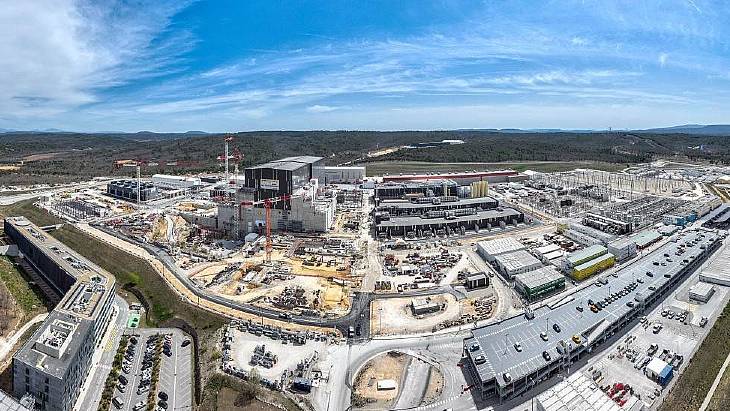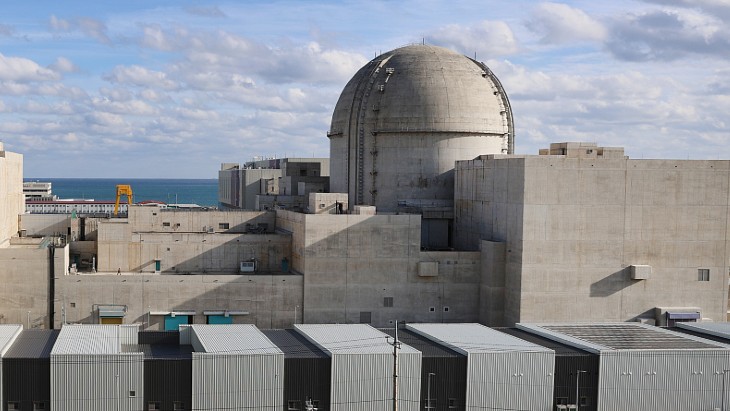ITER is a major international project to build a tokamak fusion device in Cadarache, France, designed to prove the feasibility of fusion as a large-scale and carbon-free source of energy. The goal of ITER is to operate at 500 MW (for at least 400 seconds continuously) with 50 MW of plasma heating power input. It appears that an additional 300 MWe of electricity input may be required in operation. No electricity will be generated at ITER.
Thirty five nations are collaborating to build ITER - the European Union is contributing almost half of the cost of its construction, while the other six members (China, India, Japan, South Korea, Russia and the USA) are contributing equally to the rest. Construction began in 2010 and the original 2018 first plasma target date was put back to 2025 by the ITER council in 2016.
Given the scale of the project and its first-of-a-kind nature, delays to the schedule have not been unexpected as construction of buildings and other equipment with unique technical specifications has been taking place.
But the ITER project team believed that until COVID-19 hit France, with lockdowns, "we were generally staying on track for first plasma in 2025" and that delays could be "recovered". However, COVID-19 made clear that could not happen: "Multiple factories making ITER components shut down - some for months - and when they restarted in some instances it was not with the same workforce or expertise," ITER says.
Although it has been accepted since the height of the pandemic in 2020 that there would have to be a delay to the 2025 first plasma target date, it has not yet been revised because the ITER council asked the organisation to continue to monitor and report on the situation as the pandemic and its impact continued. As ITER put it, "it made no sense to set a new baseline when we did not have all the information".
Last month a proposed new timeframe was presented to the ITER council, but the council has launched its search for a new director general, following Bernard Bigot's death in May, and it wants to ensure that any new baseline date is "owned" by the new director general. This means that, although the new director general may be announced in September it is not expected that there will be a new schedule agreed and unveiled until April 2023.
An ITER spokesman pointed out that the 2025 target date had been set with no contingency, when the European or US norm for such a project might be a 50-75% contingency in terms of schedule and cost.
"For a project of this complexity, with so many first-of-a-kind components scheduled to arrive at the height of the pandemic, ITER’s relentless progress has been remarkable. Whatever emerges as the new project baseline, even with COVID delays incorporated, it will be far less than a standard EU/US project contingency," they said.
The ITER project is subject to oversight by the French nuclear regulator, the Autorité de Sûreté Nucléaire (ASN). In its latest update it says: "The year 2021 was marked in particular by the preparation of the first sector of the vacuum chamber, with the installation of its equipment and thermal protection in the assembly hall, in order to be able to transfer it to the shaft of the Tokamak building at a later date. A second sector has arrived on site and must also be equipped."
It added that "work on the site and the manufacture of equipment are continuing" although there would be a delay to the 2025 target and "the revision of the schedule, integrating the assessment of the impact of the COVID-19 pandemic, is still awaited".
In May this year ITER achieved a major machine assembly milestone, with the first sub-section of the ITER plasma chamber being lifted out of tooling and lowered into the machine well. ITER's plasma chamber, or vacuum vessel, houses the fusion reactions and acts as a first safety containment barrier. It will be formed from nine wedge-shaped steel sectors that measure over 14 metres in height and weigh 440 tonnes. The sector sub-assembly tools - each about 22 metres in height and weighing around 860 tonnes - are designed to support the weight of one vacuum vessel sector, two toroidal field coils and silver-coated thermal shields, which together weigh some 1200 tonnes.
Following a full pre-lift test, the first full sector subassembly - consisting of the double-walled vacuum vessel sector, a tightly fitted thermal shield and two D-shaped vertical superconducting electromagnets called toroidal field coils - was transferred from the assembly hall into the tokamak pit.





_30199.jpg)
_72306.jpg)







